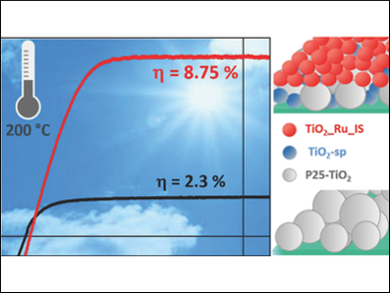Dye-sensitized solar cells (DSSCs) are a low-cost alternative to conventional silicon-based solar cells. DSSCs still need to be improved before they can be widely used. Ideally, their sintering temperature should be below the 450–500 °C range to lower costs and enable the use of low-heat-resistant materials. Additionally, the dyes and devices need to have good long-term stability.
Elena Serrano, Universidad de Alicante, Spain, Rubén D. Costa, University of Erlangen-Nuremberg, Erlangen, Germany, and IMDEA Materials Institute, Madrid, Spain, and colleagues have developed a new strategy for the design of low-temperature-sintered DSSCs. The team integrated hybrid nanoparticles into the solar cells’ photoelectrode to improve the devices’ properties. The researchers synthesized the hybrid nanoparticles, which incorporate the ruthenium(II)-based dye N3 in titania, using a co-condensation of tetrabutyl orthotitanate (TBOT) as the titania precursor with the N3 dye. They then layered the resulting hybrid material over commercially available P25 titania nanoparticles and sintered the resulting multilayered electrodes at 200 °C for 30 min.
The hybrid material improves the charge collection efficiency, photoconversion efficiency, and stability of DSSCs. According to the researchers, this can be attributed to an improved balance between charge transport and charge recombination in the material, as well as to improved dye stability caused by the integration of the dye in the titania network. The resulting solar cells have the highest efficiency for low-temperature-sintered DSSCs reported to date.
- Hybrid Dye-Titania Nanoparticles for Superior Low-Temperature Dye-Sensitized Solar Cells,
Andreas Kunzmann, Silvia Valero, Ángel E. Sepúlveda, Marisa Rico-Santacruz, Elena Lalinde, Jesús R. Berenguer, Javier García-Martínez, Dirk M. Guldi, Elena Serrano, Rubén D. Costa,
Adv. Energy Mater. 2018.
https://doi.org/10.1002/aenm.201702583


